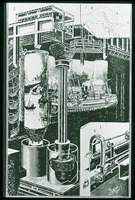Mareorama
D'Alesi, F. Hugo

Download107933_cp.jpg (304.7Kb)
Date
1900Description
The Mareorama was an entertainment attraction at the 1900 Paris Exposition. It was created by Hugo d'Alesi, a painter of advertising posters, and was a combination of moving panoramic paintings and a large motion platform. It is regarded as one of the last major developments in the technology of panoramas, shortly before the medium became obsolete.
The attraction was located inside a building in the amusement section, on the Champ de Mars. It presented spectators with a simulated sea voyage from Marseille to Yokohama, passing by Algiers, Naples, Istanbul, the Suez Canal, Sri Lanka, and Singapore. It consisted of a 70 m (230 foot) long replica of a steamship and 2 panoramas (one for the port side, one for the starboard) on large rollers. It could accommodate up to 700 passengers at a time.
The two paintings were continuous images of the sea and shoreline from the trip. They were each 750 m (2,460 feet) long and 13 m (42.5 feet) tall. To create them, d'Alesi sketched the highlights from a year-long trip he took between Marseille and Yokohama. He then directed a large team of decorative and scene painters for eight months, to transfer the sketches onto the 20,000 m² (215,000 square feet) of canvas. Mounted on large cylinders supported by floats, and driven by hydraulic motors, the two canvases unrolled past the spectators over the course of the simulated journey. The upper edge of each canvas was hooked to small trolleys on a rail and reinforced with a thin steel band to prevent sagging. The cylinders themselves were concealed by curtains and props.
Spectators stood on a platform which represented the deck of a steamship, complete with smoking funnels and steam whistles. In order to give it a rolling and pitching motion, it was mounted on a 5 m (16 foot) square iron frame on a gimbal. A combination of hydraulic cylinders, chains, and electric motors allowed the platform to pitch by up to 50 cm (20 inches) from horizontal, and to roll by up to 20 cm (8 inches).
To add to the illusion of a sea voyage, fans created an ocean breeze, which whistled in the rigging. Lighting effects created day- and night-time, as well as flashes of lightning. There were also sounds of the ship's screw and the steam siren. Seaweed and tar provided an olfactory element of the simulation. Finally, the whole experience was complemented by actors portraying deck hands, rushing about, "ostensibly to help anyone who may suffer from mal de mer". general view, view of mechanized movement of panoramic around ship platform
Type of Work
PanoramaSubject
Fairs, Exposition universelle internationale de 1900 (Paris, France), Exhibitions, Amusement rides, Panoramas, Simulation, Ships
Rights Statement
All rights reserved
Item is Part of
131900